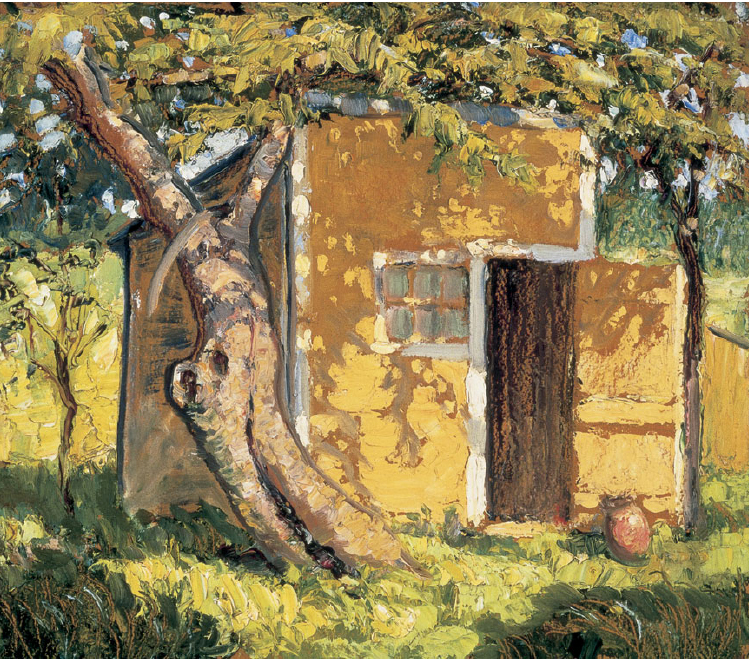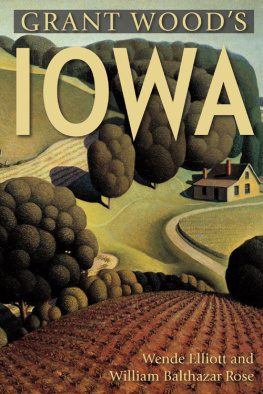

Woman with Plants (1929), Grant Wood Oil on upsom board, 20 17 in., Museum purchase. 31.1. Cedar Rapids Museum of Art
Copyright 2013 by Wende Elliott and William Balthazar Rose
All rights reserved. No part of this book may be reproduced in any form or by any electronic or mechanical means, including information storage and retrieval systems, without permission in writing from the publisher, except by a reviewer, who may quote brief passages.
Maps by Paul Woodward, The Countryman Press
Book design and composition by Eugenie S. Delaney
Library of Congress Cataloging-in-Publication Data are available.
Grant Woods Iowa 978-0-88150-992-2
Published by The Countryman Press, P.O. Box 748, Woodstock, VT 05091
Distributed by W. W. Norton & Company, Inc., 500 Fifth Avenue, New York, NY 10110
Printed in the United States of America
I dedicate this book to my children, Sam, Henry and Eleanor,
who make all road trips around Iowa a raucous adventure.
W ENDE E LLIOTT

I dedicate this book to my wife,
Wende Susan Elliott, who encouraged me to return
to the United States after a 10-year absence and
brought me to the state of Iowa for the first time.
W ILLIAM B ALTHAZAR R OSE

Van Antwerp Place (1922.23), Grant Wood
Oil on composition board, 12 14 Gift of Harriet Y. and John
B. Turner II. 72.12.78. Courtesy of Cedar Rapids Museum of Art

FOREWORD
I f Iowa had an official state artist as it has a state bird and a state tree, that artist would surely be Grant Wood, whose artistic output is indelibly linked with the landscape and people of Iowa. In fact, the image on the reverse of the Iowa quarter is a detail of Woods painting Arbor Day and the image chosen for the stamp commemorating Iowas sesquicentennial was a detail of Woods painting Young Corn.
Even though Wood died in 1942, the Iowa that he depicted is still recognizable today. And, beyond all expectations, Woods art remains today as relevant as ever.
For much of his short life Wood focused his work on the Iowa of his era, a rural, agricultural state in the slow process of becoming urbanized. His memorable paintings, prints, and drawings of Iowa are a blend of truthful observation and romantic fantasy (some of his more fanciful landscapes prefigure the wildly stylized world of Dr. Seuss). But throughout his work, Wood also dealt with such crucial human issues as community, trust, hope, and history. The period of Woods mature artwork lasted less than two decades, but nearly everything he did in this brief span was part of an attempt to artistically collate his vision for a more ethical America.
Anyone who visits the twenty-first-century version of Grant Woods Iowa will find that his biographical and artistic trail leads to museums, university and college campuses, a sprawling and still active religious colony, numerous historic houses (including his original studio), the birthplace of an American president, the home of the governor of Iowa, and the Veterans Memorial building, where his magnificent stained-glass window is the centerpiece. One can also find here buildings and landscapes that have barely changed over the course of the last century.
The book before you is a wonderful way to launch into your own exploration and appreciation of the work of this son of Americas heartland, a true American original, Iowas beloved Grant Wood.
T ERRY P ITTS
Executive Director
Cedar Rapids Museum of Art
and the Grant Wood Studio
PREFACE
A s an Iowan, an organic farmer, and an art enthusiast, I must admit that setting out on the road to visit the landmarks of Grant Woods life was a sort of pilgrimage for me. I have always admired Grant Woods ability to communicate the psychological tension between the quiet sparseness and overwhelming fertility of my home state. He playfully yet respectfully presents the sensuous, graceful eternity of the land, which always humbles me as an Iowa organic farmer. I likewise feel that I know the intimidating characters in his portraits; they could be my neighbors, these people who are resourceful and enterprising enough to survive any economic crisis or series of floods and blizzards and droughts, but open and trusting enough to leave their homes unlockedand casually walk into your home at any moment, unannounced!
I moved to Iowa as an adult, and Grant Wood was the first cultural reference point I had for Iowa before I began farming in rural Story County. Now that Ive lived in Iowa for a decade, Ive determined that Grant Wood has proven a dependable ambassador for the state, because the admiration I had as an outsider for the idealized Iowan landscapes and quirky American characters has held true to my experience as an Iowan farmer. Raising three children on an Iowa farm has been a dream come true after leaving New York City. I wonder if their childhood has been very different from that of Grant Woods, sharing the same gloriously fecund landscape as a backdrop for imaginative exploration. I pray that their adulthoods will emulate Grant Woods in that their early foundation in an Iowan culture and ecology will enliven their senses, spirituality, and confidence.
For me, Grant Wood is our poet of place, and insomuch that Iowa is often called upon to represent the emblematic Heartland of the United States, he communicates a central theme in the American imagination: to remain innocent while manifesting strength. Grant Wood documents the naive spirit of our nation, which manages to frequently redeem us despite our cultural and historic foibles. The sardonic honesty of Grant Woods art mimics the frankness of the Iowa people I know, and the luminosity of his art reflects the quiet, radiant spirituality of Iowa that visitors will discover while following this guided tour.
W ENDE E LLIOTT
I have known of Grant Wood since my childhood, though the exact moment when I became aware of his painting American Gothic is not certain to me. Grant Wood had somehow written himself indelibly into my personal history of art and was part of my collection of great masters before I was even aware that art history existed.
Until my trip to his native Iowa in the spring of 2010, I had seen very little of his body of work firsthand, or for that matter the places where he lived and worked for the majority of his life. I did not expect very much from my trip in terms of either the place or the culture. I was making my trip for personal rather than cultural reasons.
It has been a genuine surprise and pleasure to come to know both the state of Iowa and the paintings of Grant Wood. Before arriving in Iowa, I flew to Chicago from England and went immediately to the Art Institute to see the collection of American masters, including OKeeffe, Hopper, and that troubling figure Albright. I scrutinized














